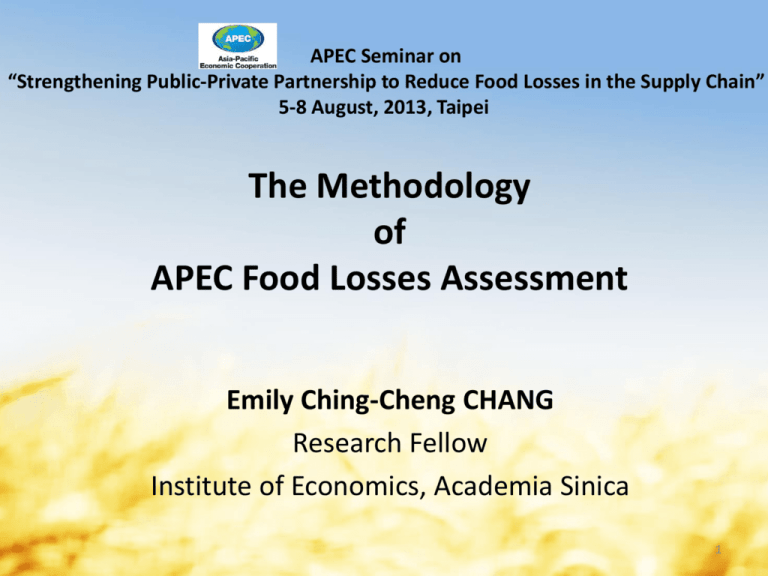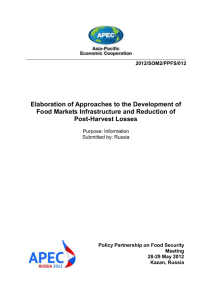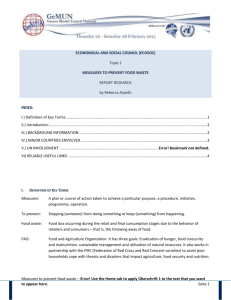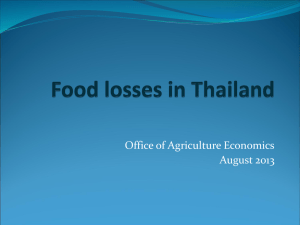The Methodology of APEC Food Losses Assessment
advertisement

APEC Seminar on “Strengthening Public-Private Partnership to Reduce Food Losses in the Supply Chain” 5-8 August, 2013, Taipei The Methodology of APEC Food Losses Assessment Emily Ching-Cheng CHANG Research Fellow Institute of Economics, Academia Sinica 1 Outline • Backgrounds • Connection between FS and Food lose/waste • Current Status – By products/supply chain/level of development • Methodology for APEC • Preliminary Results 2 Background PHL reduction matters because its absence will –Reduce availability of food –Reduce quality, safety, nutritional values –Raise costs of production and distribution –Lower sectoral value-added 3 Recent Trend of Food Price Index As food prices continued to rise, the stakes got higher So has the opportunity cost of post-harvest losses Source: FAO, World Food Situation: FAO Food Price Index 4 High incidence of PHL toward food insecurity Globally speaking, food losses and waste: – 1.3 billion ton/yr – Over 1/3 – 1/2 of production – Over USD 450 billion/yr – By 2020, estimated to increase by 40% 5 PHL by region (kg/ per person per year) • Food Losses – Europe and N America (180-190 kg) – Industrialized Asia (160 kg) – Southeast Asia (110-160 kg) • Food Wastage – Europe and N America (80-100 kg) – Industrialized Asia (80 kg) – Southeast Asia (5-10 kg) 6 Connection between PHL and Food Security/Safety SOURCE: Opara, L. “Novel Postharvest Technologies for Food Security and Safety.” http://www.globalsciencecollaboration.org/public/site/PDFS/food/Opara%20L.%20Novel% 20Postharvest%20Technologies%20for%20Food%20Security%20and%20Safety.pdf “7 Research Needed • Quantify extent and economic cost of PHL in APEC region • Calculate how much reduction of PHL would be required to end hunger in APEC region • Determine whether reducing PHL would enable food security in APEC region 8 Extent of Food Losses and Waste –By stages of supply chain – By member economies – By products 9 By Product & Stage Source: Gustavsson et al .(2011), Global Food Losses and Food Waste: Extent Causes and Prevention, FAO, Rome. 10 Methodology • Commodity System Analysis (CSA) – CSA is widely use on postharvest handling and marketing of a given commodity. – CSA is made up of27 components that together account for all the steps associated with the production • Mass Flow Model (MFM) – MFM is developed by the Swedish Institute for Food and Biotechnology (SIK) – Using available food balance sheet data – Aimed to human consumption – Quantify physical mass throughout the supply chain using SIK own assumptions 11 Commodity System Analysis (CSA) • 26 components • Each component is potentially important • But not always relevant for all commodities • Permits analysis of a whole commodity systems • Requires a multidisciplinary team • Data collection is costly Source: La Gra et al.1990 Problem of CSA • Losses for developing country records do not exist • Do not cover a long enough period of time • Assessment are only estimated by several observers • Records may not truly represent a continuing situation, for example : 1. losses may have been calculated only when unusually high or low 2. loss figures may be deliberately over- or understated in order to gain benefits or to avoid embarrassment 13 Mass Flow Model (MFM) Source: Linpinski et al .(2013) Creating a Sustainable Food Future, Installment Two: Reducing Food Loss and Waste 14 FAO Food Balance Sheet Mass Flow Allocation Ratio - To determines the part of food that is allocated for human consumption. Food (Fresh) (L) Food (K) Food (Processed) (M) Allocation factors wheat maize rice Europe 35% 35% 35% North America & Oceania. 50% 50% 50% Industrialized Asia 60% 60% 60% Sub-Saharan Africa 75% 75% 75% North Africa, West & Central Asia. 60% 60% 60% South & Southeast Asia Latin America 67% 40% 67% 40% 67% 40% Formulae for Food Losses and Waste Calculation Losses & Waste along Supply Chain Handling & Storage Production LW1=A* (❶/ (1+❶)) LW2=A*❷ Processing & Packaging LW3=(L+H)*❸ Distribution & Market LW4=K*❹ Lw5= (L+H-LW3)*❺ Consumption LW6=(K-LW4)*❻ LW7=(L+H-LW3-LW5)*❼ ID Balance Sheet item ID Loss Ratios A Production ❶ Production H Processing ❷ Handling & Storage K Food (Fresh) ❸ Processing and Packaging L Food (Processed) ❹ Distribution (Fresh) ❺ Distribution (Processed) ❻ Consumption (Fresh) ❼ Consumption (Processed0 Loss Ratios along the Food Supply Chain North America & Oceania., Russia. Cereals Roots & Tubers Oilseeds & Pulses Fruit & Vegetables Meat Fish & Seafood Milk Production 2% 20% 12% 20% 3.50% 12% 3.50% Handling and storage 2% 10% 0% 4% 1.00% 0.50% 0.50% Processing and packaging 0.5%,10% 15% 5% 2% 5% 6% 1.20% Distribution Retail Market 2% 7% 1% 12% 4% 9% 0.50% 27% 30% 4% 28% 11% 33% 15% Consumption Industrialized Asia Production 2% 20% 6% 10% 2.90% 15.00% 3.50% 10% 7% 3% 8% 0.60% 2.00% 1% Processing and packaging 0.5%,10% 15% 5% 2% 5% 6% 1.20% Distribution Retail Market 2% 9% 1% 8% 6% 11% 0.50% 20% 10% 4% 15% 8% 8% 5% Handling and storage Consumption South & Southeast Asia Production 6% 6% 7% 15% 5.10% 8.20% 3.50% Handling and storage 7% 19% 12% 9% 0.30% 6% 6% Processing and packaging 3.50% 10% 8% 25% 5% 9% 2% Distribution Retail Market 2% 11% 2% 10% 7% 15% 10% Consumption 3% 3% 1% 7% 4% 2% Source: Gustavsson et al .(2011), Global Food Losses and Food Waste: Extent Causes and Prevention, ANNEX 4, FAO, Rome. 1% 18 Preliminary Results 19 Preliminary Results Losses & Production Utilization Loss % Loss % Waste in in (mill ton) (mill ton) (mill ton) Production Utilization Wheat 34.9 292.3 236.2 11.9% 14.8% Maize 46.8 567.7 548.0 8.3% 8.5% Rice 39.8 256.6 242.4 15.5% 16.4% 20 Preliminary Results-1 Per capita loss by weight (Kg) • Wheat: 1~43 kg (15 kg avg per year) • Maize: 1~66 kg (11 kg avg per year) • Rice: 1~38 Kg (13 kg avg per year) 21 Preliminary Results-2 Convert into per capita calorie losses (Kcal) using FAO Food Balance Sheet • Wheat: 4~367 (112 kcal avg per year) • Maize: 4~489 (80 kcal avg per year) • Rice: 8~381 (131 kcal avg per year) 22 Preliminary Results-3 Convert into per capita monetary losses (USD) using FAO producer prices*1.5 • Wheat: 2~15 (6 USD avg per year) • Maize: 1~14 (3 USD avg per year) • Rice: 1~50 (l0 USD avg per year) 24 billion 13 billion 14 billion 23 Preliminary ResultsWheat 24 Preliminary ResultsMaize Loss Ratio along FSC (Dom Utilization)- Maize 25.00% 20.00% 15.00% Consumption 10.00% Distribution Processing & Packing 5.00% Handling & Storage Production 0.00% 25 Preliminary ResultsRice 26 APEC Information Platform on Post Harvest Loss and Waste System (PHLOWS) Purpose Support C food security policy formulation Identify opportunities to improve value chains Monitor and evaluate loss reduction activities Input Data Calculator Output (Losses) (Food Balance Sheet) (Loss/Allocation/ by weight, calorie, $$$ Conversion Ratio) (Table, Graph, Map) Examined by Member Economy APIP Website 27 APIP-PHLOWS Webpage https://sites.google.com/site/apecharvestlost/ 28 Cover Page Click 29 Thank you & Comment Welcome 30








